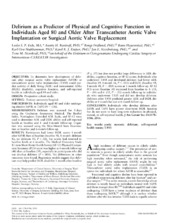| dc.contributor.author | Eide, Leslie Sofia Pareja | en_US |
| dc.contributor.author | Ranhoff, Anette Hylen | en_US |
| dc.contributor.author | Fridlund, Bengt Gotthard Anton | en_US |
| dc.contributor.author | Haaverstad, Rune | en_US |
| dc.contributor.author | Hufthammer, Karl Ove | en_US |
| dc.contributor.author | Kuiper, Karel Kier-Jan | en_US |
| dc.contributor.author | Nordrehaug, Jan Erik | en_US |
| dc.contributor.author | Norekvål, Tone M. | en_US |
| dc.date.accessioned | 2016-09-16T09:48:35Z | |
| dc.date.available | 2016-09-16T09:48:35Z | |
| dc.date.issued | 2016-06 | |
| dc.Published | Journal of The American Geriatrics Society 2016, 64(6):1178-1186 | eng |
| dc.identifier.issn | 1532-5415 | |
| dc.identifier.uri | https://hdl.handle.net/1956/12805 | |
| dc.description.abstract | Objectives: To determine how development of delirium after surgical aortic valve replacement (SAVR) or transcatheter aortic valve implantation (TAVI) could predict activity of daily living (ADL) and instrumental ADLs (IADL) disability, cognitive function, and self-reported health in individuals aged 80 and older. Design: Prospective cohort study. Setting: Tertiary university hospital. Participants: Individuals aged 80 and older undergoing elective SAVR or TAVI (N = 136). Measurements: Delirium was assessed for 5 days using the Confusion Assessment Method. The Barthel Index, Nottingham Extended ADL Scale, and SF-12 were used to determine ADL and IADL ability and self-reported health at baseline and 1- and 6-month follow-up. Cognition was assessed using the Mini-Mental State Examination at baseline and 6-month follow-up. Results: Participants had lower IADL scores 1 month after SAVR than at baseline (baseline 58, 1 month: delirium 42, no delirium 50, P ≤ .02), but scores had returned to baseline levels at 6 months. The Medical Outcomes Study 12-item Short-Form Health Survey (SF-12) Physical Component Summary (PCS) score was higher at 6-month follow-up (48) than at baseline (39), especially in participants who did not develop delirium (P < .001). No differences in other outcomes were found. Regression models suggest that delirium may help predict IADL disability 1 month after baseline (P ≤ .07) but does not predict large differences in ADL disability, cognitive function, or SF-12-scores. Individuals who underwent TAVI and developed delirium had lower ADL (baseline 19, 1-month 16, P < .001) and IADL (baseline 49, 1-month 40, P = .003) scores at 1-month follow-up. SF-12 PCS score (baseline 30) increased from baseline to 1- (35, P = .04) and 6- (35, P = .02) month follow-up in individuals who underwent TAVI and did not develop delirium. Delirium after TAVI predicted greater ADL and IADL disability at 1-month but not at 6-month follow-up. Conclusion: Individuals who develop delirium after SAVR and TAVI have poorer short-term IADL function but do not seem to have long-term reductions in physical, mental, or self-reported health. | en_US |
| dc.language.iso | eng | eng |
| dc.publisher | Wiley | eng |
| dc.relation.ispartof | <a href="http://hdl.handle.net/1956/12806 " target="blank">Delirium after Aortic Valve Therapy. A Prospective Cohort Study of Octogenarian Patients following Surgical Aortic Valve Replacement and Transcatheter Aortic Valve Implantation.</a> | |
| dc.rights | Attribution CC BY | eng |
| dc.rights.uri | http://creativecommons.org/licenses/by/4.0/ | eng |
| dc.subject | aortic stenosis | eng |
| dc.subject | delirium | eng |
| dc.subject | self-reported health status | eng |
| dc.title | Delirium as a Predictor of Physical and Cognitive Function in Individuals Aged 80 and Older After Transcatheter Aortic Valve Implantation or Surgical Aortic Valve Replacement | en_US |
| dc.type | Peer reviewed | |
| dc.type | Journal article | |
| dc.date.updated | 2016-09-14T13:16:23Z | |
| dc.description.version | publishedVersion | en_US |
| dc.rights.holder | Copyright 2016 The Authors | |
| dc.identifier.doi | https://doi.org/10.1111/jgs.14165 | |
| dc.identifier.cristin | 1368763 | |

